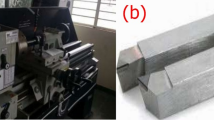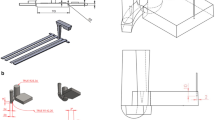Abstract
In this work, an alumina-yttrium aluminum garnet (Al2O3-YAG) cutting tool was developed and characterized aiming application in dry machining of nodular (spheroidal) cast iron. Ceramic powders containing 85 wt.% Al2O3 and 15 wt.% Y3Al5O12(YAG) were homogenized, compacted, and sintered at 1600 °C for 2 h at a heating rate of 5 °C/min. The sintered ceramic presented relative density of 98.3 ± 0.2%. X-ray diffraction (XRD) and scanning electron microscopy (SEM) revealed α-Al2O3 and YAG as crystal phases, both with equiaxed grains with average sizes of 1–4 μm (Al2O3 phase) and 0.7–1 μm (YAG phase). In addition, this ceramic composite presented Vickers hardness and fracture toughness of 15.2 ± 0.2 GPa and 4.6 ± 0.3 MPa.m1/2, respectively. The dry machining performance of the Al2O3-YAG cutting tool was compared with that of a commercial cemented carbide cutting tool using cutting speed (VC) of 200 and 500 m/min, feed rate (f) of 0.25 and 0.10 mm/rev, and axial depth of cut (ap) of 0.60 mm. The results showed that the best setting for the cemented carbide cutting tool was obtained at VC = 200 m/min and f = 0.25 mm/rev, which produced the best machinability with average surface roughness (Ra) of 3.516 μm, cutting length (LC) of 6000 m, and maximum flank wear (VBmax) of 0.58 mm. For the Al2O3-YAG cutting tool, the best setting was achieved at VC = 500 m/min and f = 0.10 mm/rev, which produced Ra = 0.848 μm, LC = 12,293 m, and VBmax = 0.54 mm.







Similar content being viewed by others
References
Paneto FJ, Pereira JL, Lima JO, Jesus EJ, Silva LA, Sousa LE, Cabral RF, Santos C (2015) Effect of porosity on hardness of Al2O3-Y3Al5O12 ceramic composite. Int J Refract Metal Hard Mater 48:365–368. https://doi.org/10.1016/j.ijrmhm.2014.09.010
Camuşcu N (2006) Effect of cutting speed on the performance of Al2O3 based ceramic tools in turning nodular cast iron. Mater Des 27:997–1006. https://doi.org/10.1016/j.matdes.2005.02.011
Norfauzi T, Hadzley AB, Azlan UAA, Afuzaa AA, Faiz MM, Naim MF (2019) Fabrication and machining performance of ceramic cutting tool based on the Al2O3-ZrO2-Cr2O3 compositions. J Mater Res Technol 8(6):5114–5123. https://doi.org/10.1016/j.jmrt.2019.08.034
Du W, Ai Y, He W, Chen W, Liang BL, Lv C (2020) Formation and control of intragranular ZrO2 strengthened and toughened Al2O3 ceramics. Ceram Int 46(6):8452–8461. https://doi.org/10.1016/j.ceramint.2019.12.080
Banik SR, Iqbal IM, Nath R, Bora LJ, Singh BK, Mandal N, Sankar MR (2019) State of the art on zirconia toughened alumina cutting tools. Mater Today Proc 18(7):2632–2641. https://doi.org/10.1016/j.matpr.2019.07.123
Bučevac D, Omerašević M, Egelja A, Radovanović Ž, Kljajević L, Nenadović S, Krstić V (2020) Effect of YAG content on creep resistance and mechanical properties of Al2O3-YAG composite. Ceram Int 46(10 Part B):15998–16007. https://doi.org/10.1016/j.ceramint.2020.03.150
Song JG (2010) Oxidation Behavior of ZrB2–YAG–Al2O3 Ceramics at high temperature. Mater Manuf Processes 25(8):724–729. https://doi.org/10.1080/10426910903229362
Yao B, Su H, Zhang J, Ren Q, Ma W, Liu L, Fu H (2016) Sintering densification and microstructure formation of bulk Al2O3/YAG eutectic ceramics by hot pressing based on fine eutectic structure. Mater Des 92:213–222. https://doi.org/10.1016/j.matdes.2015.12.017
Lach R, Wojteczko K, Dudek A, Pedzich Z (2014) Fracture behaviour of alumina-YAG particulate composites. J Eur Ceram Soc 34:3373–3378. https://doi.org/10.1016/j.jeurceramsoc.2014.04.020
Parthasarathy TA, Mah T, Matson LE (2004) Processing, structure and properties of alumina-YAG eutectic composites. J Ceram Process Res 5(4):380–390
Rakshit R, Das AK (2019) A review on cutting of industrial ceramic materials. Precis Eng 59:90–109. https://doi.org/10.1016/j.precisioneng.2019.05.009
Sharma V, Pandey PM (2016) Recent advances in turning with textured cutting tools: a review. J Clean Prod 137:701–715. https://doi.org/10.1016/j.jclepro.2016.07.138
Yigit R, Celik E, Findik F, Koksal S (2008) Effect of cutting speed on the performance of coated and uncoated cutting tools in turning nodular cast iron. J Mater Process Technol 204:80–88. https://doi.org/10.1016/j.jmatprotec.2007.10.082
Grzesik W, Kiszka P, Kowalczyk D, Rech J, Claudin C (2012) Machining of nodular cast iron (PF-NCI) using CBN tools. Procedia CIRP 1:483–487. https://doi.org/10.1016/j.procir.2012.04.086
García J, Ciprés V, Blomqvist A, Kaplan B (2019) Cemented carbide microstructures: a review. Int J Refract Metal Hard Mater 80:40–68. https://doi.org/10.1016/j.ijrmhm.2018.12.004
Warmuzek M, Polkowska A (2020) Micromechanism of damage of the graphite spheroid in the nodular cast iron during static tensile test. J Manuf Mater Process 4(22):1–19. https://doi.org/10.3390/jmmp4010022
Bayraktar S (2021) Dry cutting: a sustainable machining technology. In Sustainable Manufacturing, Handbooks in Advanced Manufacturing, pp 231–257. https://doi.org/10.1016/B978-0-12-818115-7.00004-3
Akhtar SS (2021) Review - a critical review on self-lubricating ceramic-composite cutting tools. Ceram Int. In press. https://doi.org/10.1016/j.ceramint.2021.04.094
ISO 1832:2017 Indexable inserts for cutting tools – Designation, ISO, 2017
ASTM C1327:2015 Standard test method for Vickers indentation hardness of advanced ceramics, ASTM, 2015
ASTM C1421:2018 Standard test method for determination of fracture toughness of advanced ceramics at ambient temperature, ASTM, 2018
González H, Calleja A, Pereira O, Ortega N, Lopez de Lacalle LN, Barton M (2018) Super abrasive machining of integral rotary components using grinding flank tools. Metals 8(1):24. https://doi.org/10.3390/met8010024
ISO 5608:2012 Turning and copying tool holders and cartridges for indexable inserts - Designation, ISO, 2012
Rajain K, Sliusarenko O, Bizzarri M, Barton M (2022) Curve-guided 5-axis CNC flank milling of free-form surfaces using custom-shaped tools. Comput Aided Geom Des 94:102082
Escudero GG et al (2022) 5-axis double-flank CNC machining of spiral bevel gears via custom-shaped tools—Part II: Physical validations and experiments. Int J Adv Manuf Technol 119(3):1647–1658
Barton M, Bizzarri M, Rist F, Sliusarenko O, Pottmann H (2021) Geometry and tool motion planning for curvature adapted CNC machining. ACM Trans Graph 40(4):1–16
Souza JVC, Nono MCA, Ribeiro MV, Machado JPB, Silva OMM (2009) Cutting forces in turning of gray cast iron using silicon nitride based cutting tool. Mater Des 30:2715–2720. https://doi.org/10.1016/j.matdes.2008.09.041
ISO 4287:1997 Geometrical product specifications (GPS) - surface texture: profile method - terms, definitions and surface texture parameters, ISO, 1997
ABNT/NBR 6916:2017 Nodular cast iron or spheroidal graphite cast iron – Specification, ABNT, 2017
Banik SR, Iqbal IM, Nath R, Bora LJ, Singh BK, Mandal N, Sankar MR (2019) State of the art on zirconia toughened alumina cutting tools. Mater Today Proc 18:2632–2641. https://doi.org/10.1016/j.matpr.2019.07.123
ISO 3685:1993 Tool-life testing with single-point turning tools, ISO, 1993
Shi JL, Li L, Guo JK (1998) Boundary stress and its effect on toughness in thin boundary layered and particulate composites: model analysis and experimental test on T-TZP, based ceramic composites. J Eur Ceram Soc 18:2035–2043
Shi JL, Lu ZL, Guo JK (2000) Model analysis of boundary residual stress and its effect on toughness in thin boundary layered yttria-stabilized tetragonal zirconia polycrystalline ceramics. J Mater Res 15(3):727–732
Taya M, Hayashi S, Kobayashi AS, Yoon HS (1990) Toughening of a particulate-reinforced ceramic-matrix composite by thermal residual stress. J Am Ceram Soc 73(5):1382–1391
Pauling L, Hendricks SB (1925) The crystal structures of hematite and corundum. J Am Chem Soc 47(3):781–790
Bagdasarov KS et al (1991) Photoinduced effects and real structure of crystals of yttrium aluminum garnet. Sov Phys Crystallogr 36(3):398–405
Bo P, Bartoň M (2019) On initialization of milling paths for 5-axis flank CNC machining of free-form surfaces with general milling tools. Comput Aided Geom Des 71:30–42
Zhang X, Zhang J, Zheng X, Pang B, Zhao W (2017) Tool orientation optimization of 5-axis ball-end milling based on an accurate cutter/workpiece engagement model. CIRP J Manuf Sci Technol 19:106–116
Brandt G, Gerendas A, Mikus M (1990) Wear mechanisms of ceramic cutting tools when machining ferrous and non-ferrous alloys. J Eur Ceram Soc 6(5):273–290
Lartigue C, Tournier C, Ritou M, Dumur D (2004) High-performance NC for HSM by means of polynomial trajectories. CIRP Ann 53(1):317–320
Amaitik SM, Taşgin TT, Kilic SE (2006) Tool-life modelling of carbide and ceramic cutting tools using multi-linear regression analysis. Proc Inst Mech Eng B J Eng Manuf 220(2):129–136
Souza JVC, Silva OMM, Nono MCA, Machado JPB, Pimenta M, Ribeiro MV (2011) Si3N4 ceramic cutting tool sintered with CeO2 and Al2O3 additives with AlCrN coating. Mater Res 14(4):514–518. https://doi.org/10.1590/S1516-14392011005000077
Mandal N, Doloi B, Mondal B (2013) Predictive modeling of surface roughness in high speed machining of AISI 4340 steel using yttria stabilized zirconia toughened alumina turning insert. Int J Refract Metal Hard Mater 38:40–46. https://doi.org/10.1016/j.ijrmhm.2012.12.007
Funding
The authors would like to thank LABNANO–CBPF for the technical support provided to the electron microscopy work. Dr. Claudinei dos Santos thanks CNPq (grant no. 311119/2017–4) for the financial support.
Author information
Authors and Affiliations
Corresponding author
Ethics declarations
Conflict of interest
The authors declare no competing interests.
Consent for publication
The authors of that article accept and give the license to publish to the journal Advanced Manufacturing Technology or another one of your property.
Additional information
Publisher's Note
Springer Nature remains neutral with regard to jurisdictional claims in published maps and institutional affiliations.
Rights and permissions
Springer Nature or its licensor holds exclusive rights to this article under a publishing agreement with the author(s) or other rightsholder(s); author self-archiving of the accepted manuscript version of this article is solely governed by the terms of such publishing agreement and applicable law.
About this article
Cite this article
de Sousa, L.F., Simba, B.G., de Souza, J.V.C. et al. Dry machining of nodular cast iron using a YAG-reinforced alumina ceramic cutting tool. Int J Adv Manuf Technol 123, 99–110 (2022). https://doi.org/10.1007/s00170-022-10149-8
Received:
Accepted:
Published:
Issue Date:
DOI: https://doi.org/10.1007/s00170-022-10149-8




